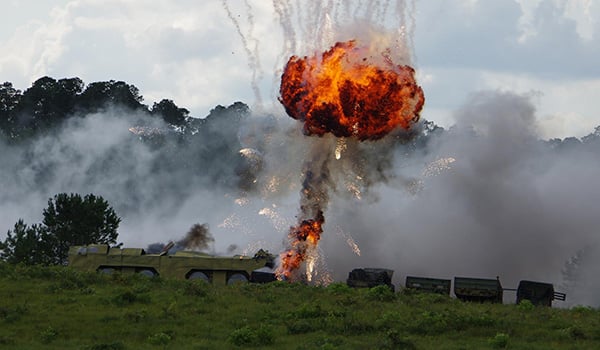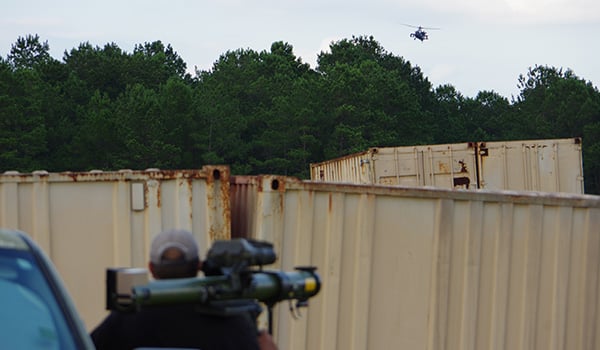
Joint Readiness Training Center / By LTC Linn Desaulniers, MAJ Jeffrey Ferguson, and CPT Kevin Burns: Alpha Team – the Joint Readiness Training Center (JRTC) Operations Group Aviation Division at Fort Polk, LA – functions as a diverse team of observers, coaches, and trainers (OC/Ts) who interface with the ten U.S. Army Forces Command (FORSCOM)-directed aviation battalion task forces (ABTF) that deploy here each fiscal year. Our team, nested within the unique rotational designs developed by Operations Group, provides a challenging and demanding training scenario that incorporates all six warfighting functions (WfF) while generating maneuver and lethality options for the supported brigade combat team (BCT) as they attempt to seize and maintain initiative. As our newest doctrine is published and world conflict continues to develop, we at Alpha Team assert and impart an umbrella mindset to every rotational unit (RTU) that deploys to JRTC: the employment of unified land operations will continue to evolve in complexity and Army Aviation’s place in the operational environment will continue to develop alongside emerging requirements. During every rotation, we condense what could be several months’ worth of combat operations into a detailed fourteen-day force-on-force scenario constructed to test the capabilities and flexibility of each ABTF that deploys to this combat training center (CTC).

Getting Ready For JRTC
We emphasize that the RTU should not try to “beat” JRTC; units should apply the same premise when focusing on their home-station training plans or their operational Military Decision Making Process (MDMP). The sheer flexibility of our rotational design could exhaust any course of action development or war gaming effort into an infinite staffing nightmare. Rather, we underscore the importance of the operational force communicating with us early so that we can help shape your training event. There are multiple outreach opportunities that facilitate this discussion and planning. Along with the mandated initial planning conferences, mission letters, etc., we provide an initial outreach from Alpha Team at approximately 180 days to initiate communication between our team and yours. During JRTC’s Leader Training Program (LTP), the senior leaders of Alpha Team meet with the RTU leadership and staff to further bridge the gap of “us vs. them” with some insightful lessons learned and best practices. As commanders shape and approve their unit training plans, they should consider the following question: how can the combat training center help meet these training requirements and objectives? While the complexity of a rotation is taxing, it is still an ideal time to embed your own training objectives within the rotational scenario. We have seen this in a couple different fashions thus far; for example, one combat aviation brigade (CAB) began early outreach to provide a CAB(-) worth of aircraft (24 x UH-60M and 9 x CH-47s for the assaulting force) to support one of the largest joint forcible entries (JFE) that we have ever executed. This training opportunity, executed by the RTU but fully resourced by Operations Group during the rotation, both validated their CAB Standard Operating Procedures (SOP) and generated additional options for that BCT commander as he employed his forces against the scenarios’ demanding requirements. This CAB further nested their general support aviation battalion (GSAB) Table XII requirements into the live fire exercise (LFX) scenario at the Peason Ridge Range Complex, which was synchronized and staffed only due to their progressive approach. The sheer complexity of these two missions would normally have required a division staffing effort to coordinate and synchronize the training events. If it were not for their foresight in their training plan and initiative of reaching out to our team, these objectives would not have been incorporated into their rotation.

Upward Trending
Recently, there have been numerous ABTFs that have deployed to JRTC after already completing a multitude of training events and building relationships with the supported BCT. This has yielded tremendous amounts of success as the leadership weighs the stressors of the operational design and as they face new problem sets during the execution phase of operations. ABTFs have provided feedback to our team that this early and necessary relationship-building helped bridge the gaps as units self-discovered friction points between their own SOPs, as they “ironed-out” reporting requirements/formats, and even as they developed and shared respective commander’s intent. On a larger scale, this cross-pollination also yields a better-prepared BCT staff with regards to the deliberate and detailed planning required to employ aviation assets.
Training In Atropia
The challenge, which remains ours to meet and master, is to provide the most realistic threat possible to train ABTFs on the tactical employment of Army Aviation assets. One of the ways we accomplish this is the execution of a “deep attack” mission that takes place on a nearby Air Force range complex. Through this partnership, we provide a live radar threat mission that is resourced with an Integrated Air Defense System (IADS) armament of visually modified targets that need to be prosecuted from the attack aviation platforms. With our organic role-play personnel acting as the opposition force (OPFOR), we employ the man-portable aircraft survivability trainer (MAST) to replicate the man-portable air defense (MANPAD) threat relevant to our near-peer threats worldwide. By emplacing multiple integrated laser engagement system (MILES) equipment on all of the targets coupled with our contracted fire markers’ pyrotechnics, we provide as near real-time battlefield effects as possible. This training scenario stresses all of the WfFs during all phases of the operation (plan, prepare, execute, and assess). During pre-mission planning, the ABTF is challenged by assessment of the threat they are up against and by utilization of micro-terrain in order to gain lines of inter-visibility. The stress and importance of rehearsals quickly materializes as the attack aviation platforms feel the lethality of these Air Defense Artillery (ADA) pieces through the timely adjudication of tactical errors. Failures in the planning process result in immediate reduction of combat power during execution via simulated aircraft damage or destruction. As an example, this problem set, a shaping operation for the division that requires the ABTF to meet destruction criteria set in their operations order (OPORD) to successfully accomplish their mission, is a realistic approach to breaking the paradigm of the counterinsurgency (COIN) mentality. This training scenario further stresses the staffing efforts at the ABTF by replicating operations in the joint environment and incorporation of suppression of enemy air defense (SEAD).
Investing In Army Aviation
As world politics and U.S. interests abroad continue to shape our operational requirements, we at Alpha Team stand ready to provide the most realistic, rigorous, and relevant training available. As our civilian partners in industry continue to enhance realism with advancements in our simulations capabilities, our training scenarios will better prepare our aviators as they go forth in the execution of their missions. Alpha Team answers the call of our operational force by providing world-class training for every ABTF that deploys to JRTC.
No Slack!
LTC Linn Desaulniers is the Senior Aviation Trainer, MAJ Jeffrey Ferguson is the Aviation Task Force Executive Officer Trainer, and CPT Kevin Burns is the Aviation Task Force Operations Officer Trainer for Alpha Team, Joint Readiness Training Center, Fort Polk, LA.








